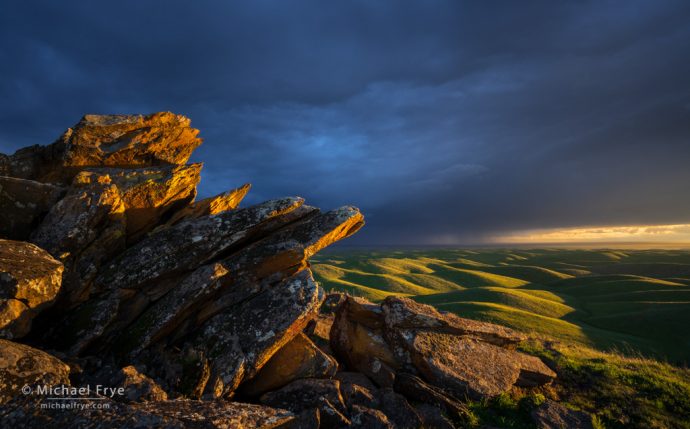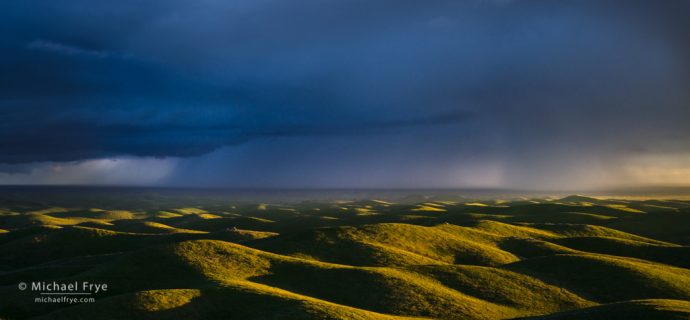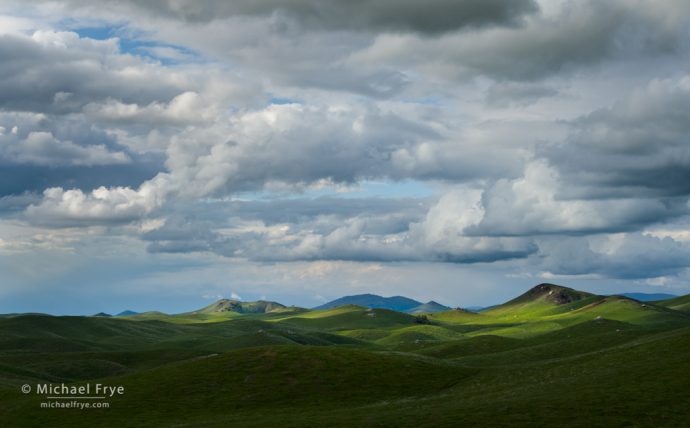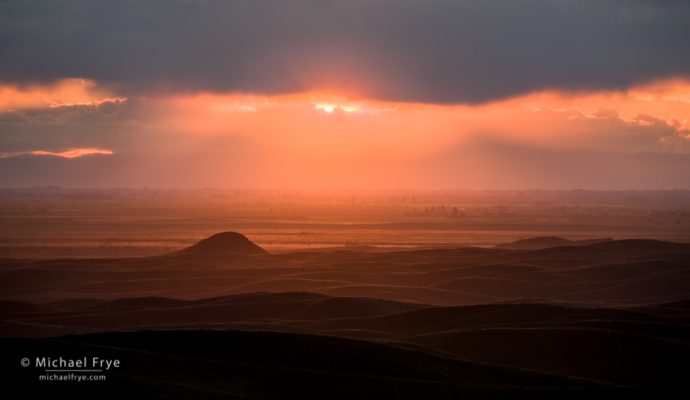
Late-afternoon light in the Sierra Nevada foothills. Most of the photographs I made this afternoon didn’t include a foreground. But I saw this rock outcrop, and kept it in mind for the right opportunity. That opportunity came when the sun slid underneath the clouds and highlighted the jagged forms of the outcrop. 16mm, 1/20th sec. at f/16, ISO 400.
Our winter got off to a wet start in late November and early December, but then fizzled. We hardly got any precipitation during most of December, January, and February – traditionally the wettest months of the year in California, when we get the bulk of our annual rainfall.
That pattern changed a bit in March, with a few good storms to help replenish the previously-anemic Sierra snowpack. And one of our largest storms since last spring is moving into California right now, with forecasters predicting three to four feet of snow above 7,000 feet. Our precipitation for the water year (October 1st through September 30th) will still be below average, but these early-spring storms should, at least, leave us with a decent snowpack for this time of year, with closer-to-normal runoff in our rivers and creeks over the next couple of months, and a more typical summer in the high country.
In normal times I’d be watching this current storm closely for an opportunity to photograph Yosemite Valley as the storm cleared. But of course these aren’t normal times. Yosemite is closed, and Californians, like most people in the country, are sheltering in place.
I live, however, in a lightly-populated area, where I can drive to some scenic spots without encountering any other people, or violating any social-distancing strictures. These spots aren’t as spectacular as Yosemite, but they’re pretty, especially now, in spring, when everything is green. And I’ve said many times that locations aren’t as important light and composition. I guess this is a good time to put that to the test!
Interesting weather certainly helps, in any location. One afternoon a couple of weeks ago Claudia and I watched a beautiful parade of clouds stream past our house, bringing intermittent showers. The day called to us to get out somewhere to watch, and maybe photograph, the weather. So we packed our car and drove to a nearby spot with a view to the west over the San Joaquin Valley.
From our vantage point we watched a thunderstorm developing to the southwest. The storm gradually moved east, getting closer, but slid past us to the south. Late in the afternoon the sun dropped through a gap in the clouds, lighting up the hills around us, with dark storm clouds above. Maybe the location wasn’t spectacular, but the light certainly was.
It felt good to get out of the house and behind the camera, trying to find compositions quickly with the light changing minute by minute, completely absorbed in the moment. In other words, doing what I love most. I hope you’re able to find things to do that keep you focused and engaged, and that you love doing.
— Michael Frye

Thunderstorm over the San Joaquin Valley. I loved the mushroom-shaped cloud, and this scene lent itself perfectly to a panorama. Four frames stitched together with Lightroom’s Panorama Merge, each at 120mm, 1/60th sec. at f/11, ISO 100.

Thunderstorm and Sierra Nevada foothills. After I made the photograph at the top of this post I walked around the rock outcrop to make a tighter composition with just the sunlit hills and thunderstorm. 50mm, 1/60th sec. at f/11, ISO 400.

Clouds and rolling hills, Sierra Nevada. Made earlier in the afternoon, as the sun broke through a hole in the clouds and lit the hills. 81mm, 1/125th sec. at f/11, ISO 100.

Sunset from the Sierra Nevada foothills. Made as the sun hit the last gap in the clouds. The extreme contrast required bracketing and blending exposures; I bracketed five frames, two stops apart, and blended them with Lightroom’s HDR Merge. 330mm, varied shutter speeds at f/11, ISO 100.
Related Posts: It’s All About the Light; Photography Weather
Michael Frye is a professional photographer specializing in landscapes and nature. He is the author or principal photographer of The Photographer’s Guide to Yosemite, Yosemite Meditations, Yosemite Meditations for Women, Yosemite Meditations for Adventurers, and Digital Landscape Photography: In the Footsteps of Ansel Adams and the Great Masters. He has also written three eBooks: Light & Land: Landscapes in the Digital Darkroom, Exposure for Outdoor Photography, and Landscapes in Lightroom: The Essential Step-by-Step Guide. Michael has written numerous magazine articles on the art and technique of photography, and his images have been published in over thirty countries around the world. Michael has lived either in or near Yosemite National Park since 1983, currently residing just outside the park in Mariposa, California.









I also live in the foothills (outside Clovis) and LOVE seeing a post from you about this area. Thank you!
Thanks Josh! There are lots of beautiful places in this state – and everywhere – that aren’t in national parks.
Michael, I love all the pics you post, but these are some of my absolute favorites! They are simply stunning! Thank you for sharing not only the photos but the story behind them!
Thanks so much Claire!
Nicely done!
Thanks Malcolm!
Very nice photographs Michael. California indeed has many beautiful and great locations to photograph. Here in the area of Hollister one can find espectacular views to photograph, too. The ocean is just around the corner with Monterey and Carmel near by. I need to escape from this shelter in place to photograph more scenes. Your read and photographs are as always an inspiration to do just that.
Thanks Martin. I understand the desire too escape and photograph, but please do so only if you can avoid any contact with other people. You live in a more populated area than I do, so that might be difficult.
Beautiful work, Michael
Thanks Rob!